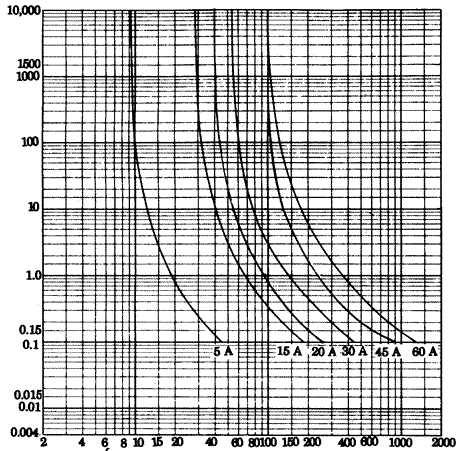The current curves are very varied with different protective devices and much depends on what you are trying to protect. Oddly the humble fuse does a better job than the MCB when protecting semi-conductor devices.
It is interesting when one overlays the different curves as to at what current each device will open first.
Although looking at the curve
it would seem the 6A fuse will not blow at 7A that is because the curve stops at 10,000 seconds or 2.7 hours if we were for example to fit a 10A BS 1362 fuse in a 3kW kettle it would likely last for years. But in a 3kW immersion heater it would likely blow as it can take hours to heat from cold. One reason why we have dedicated supply to immersion heater.
I am sure the 5A curve does intersect the 5A line at some point but that would be days not hours and much would depend on the cooling. Fuses do of course generate heat and it is the ability to remove this heat which is the major factor in long term use. We use the humble BS 1362 fuse in many different fuse holders made from many different materials mainly plastics but clearly with vastly different cooling characteristics and we should be able to put a 5A fuse in them all without it failing on 5A so clearly there must be some leeway in the exact temperature that it will blow with 5A.
With a MCB the situation is different. Here like the fuse there is a thermal component but the curve would result in the blowing time with massive overload being rather slow so also a magnetic device is incorporated designed purely for the massive overload situation.
By using two devices in one the curve is compacted but still the standard B type (6A) will still allow around 8.5A for 2.7 hours. This is clearly not what is wanted to protect motors.
So both with the fuse and with the MCB there are special ones designed for motor protection. Years ago motor protection was all magnetic and to stop them tripping on start we used an oil damper to slow the mechanism down enough for the motor to start without it tripping. We then had much more control and selecting the viscosity of the oil we could vary the time for which the overload could exist for.
But as with rewireable fuses people would cheat. EP90 in dash pot would really delay tripping. With an electrician who should understand what he is doing this is OK but with the general public to have a trip where they can vary the characteristics could be dangerous which is why now we have to use cartridge fuses where untrained people can change them.



